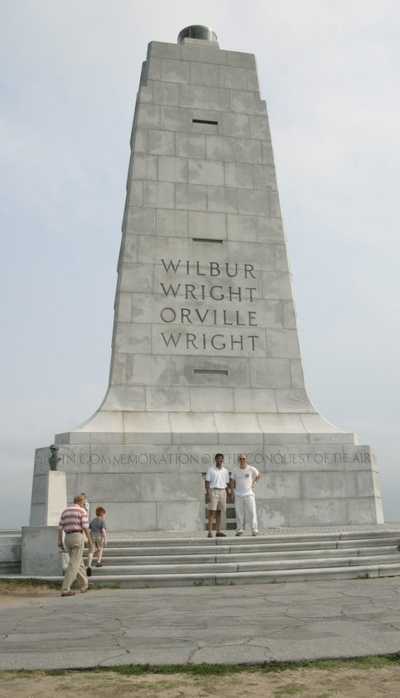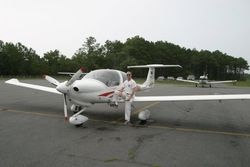Pair in Diamond Bests 2000 Record -- by More Than Double
 Laksen Sirimanne, 38, and Assaf Stoler, 31,
flew from Los Angeles Thursday and landed at Kill Devil Hills on
Friday, having set a new weight-class transcontinental record. They
averaged 135 mph in a DA40 Diamond Star.
Laksen Sirimanne, 38, and Assaf Stoler, 31,
flew from Los Angeles Thursday and landed at Kill Devil Hills on
Friday, having set a new weight-class transcontinental record. They
averaged 135 mph in a DA40 Diamond Star.
That clobbered the old record, set in 2000 -- by an Alon A2
Ercoupe. The existing record was 52.46mph.
With weather considerations and the vagaries of logistics -- not
to mention pop-up TFRs and ADIZ creations that make such planning a
real nightmare, they didn't know just when they were going to
leave, until just before the flight. "It's sinking in slowly," a
tired Assaf Stoler told ANN. "We weren't sure it was going to
happen. That's why we didn't tell anybody."
It wasn't mandatory that they land in North Carolina. There's a
certain magic there, though, especially this year: "We picked to
fly here because it is the 100th anniversary of flight," Sirimanne
told another reporter. "If two forward-thinking people could
accomplish something much more difficult here, so could we."

The FAI, through the NAA, sanctioned the record attempt
(for aircraft under 1000 kg). "The day before takeoff, 8AM, we had
the plane, the toolbox, the charts, a bottle of water, on the
scale," Assaf Stoler told ANN. "We took out anything that wasn't
permanently attached. We got to 2201 pounds -- we had three pounds
left over -- with 40.5 gallons of fuel. We decided to use half a
gallon, and take off with no more then 40 gallons. Consistentely,
we filled to 38 to 39 gallons of fuel." It wasn't just the
airplane, either: "We spent a month to lose weight," Assaf noted.
"I skipped a lot of meals -- no Cokes -- I lost 13 pounds. My
partner dieted, too -- but he was light anyway -- at takeoff, he
only weighed 129 pounds. I was 157."
Close, but on the right side of the weight limit.
 "With us, 39.5 gallons fuel,
and the stripped-down plane, we had a couple pounds left over,"
plane-owner Stoler told us. That, in itself, wasn't a big deal; but
the records people are sticky about making sure the record rules
are adhered to. "This was a problem, when every bit of fuel had to
be certified." In the daytime, during normal hours, there wasn't
any trouble, but "some airports are automated at night." that meant
they either couldn't get their fuel intake witnessed -- instant
disqualification -- or they could wait until the FBO opened. "The
biggest problem was the last fuel stop -- Sparta, Tennessee," he
said, but the "Volunteer State" still has some volunteers in it.
"The guy actually agreed to be there for us at 4AM. That was
awfully nice of him." It probably saved the record, too.
"With us, 39.5 gallons fuel,
and the stripped-down plane, we had a couple pounds left over,"
plane-owner Stoler told us. That, in itself, wasn't a big deal; but
the records people are sticky about making sure the record rules
are adhered to. "This was a problem, when every bit of fuel had to
be certified." In the daytime, during normal hours, there wasn't
any trouble, but "some airports are automated at night." that meant
they either couldn't get their fuel intake witnessed -- instant
disqualification -- or they could wait until the FBO opened. "The
biggest problem was the last fuel stop -- Sparta, Tennessee," he
said, but the "Volunteer State" still has some volunteers in it.
"The guy actually agreed to be there for us at 4AM. That was
awfully nice of him." It probably saved the record, too.
It was one thing to get on the ground at Sparta; it was another
to find the gas pump in the dark. "We found him, frantically waving
his hands." They got their purchase witnessed, and were on their
way -- one landing from the record.
In fact, everybody was nice.
" Everyone along the way was very helpful -- ATC,
flight service (checking winds aloft, the unpredicted headwind) --
they were wonderful. We planned each leg to land with at least 6
gallons of fuel. We had to change speeds, altitudes, to make the
goal."
Flying stingier meant they were able to take on less fuel --
they didn't want to bust weight. "During the whole route, we were
calculating fuel and mixture, trying to get the most out of the
airplane," Assaf explained. "We would go higher, go leaner. We had
two legs where we arrived with 10~14 gallons. The other legs, we
had 6 to 7 gallons." If they weren't near needing fuel, that didn't
matter. "We couldn't change our stops, because we had to have
someone there signing, to verify us."
The last leg was the toughest.
 "Luckily the only leg
where we had no reserve (beyond the 6 gallons), was uneventful --
we had low headwinds." Gas to spare, Mr. Stoler noted. "We landed
with 7 gallons in the tanks."
"Luckily the only leg
where we had no reserve (beyond the 6 gallons), was uneventful --
we had low headwinds." Gas to spare, Mr. Stoler noted. "We landed
with 7 gallons in the tanks."
Because they had encountered significant headwinds on virtually
the whole route, they were traveling over the ground slower than
they had planned. They had people waiting to gas them up, though --
and they didn't want them to go home. "One changed fuel stop, and
there goes the record," Assaf reminded us. "We stayed on schedule
all the way, making the ground stops faster than planned. We
planned 45 minutes, and were able to do it in 30 minutes or less,
each time. We planned Sparta at 4AM -- we were there at 4:05; We
planned Kitty Hawk at 6AM -- thanks to no headwinds, we got there
at 5:50."
He really likes his Diamond Star.
Assaf (pictured) really likes that machine and
its Lycoming power. "This airplane has the Lycoming IO-360, 180
horspower. It has very good performance, especially at high
altitude. We burned 8-9 gph, at altitude." He didn't modify the
plane, except to remove anything that wasn't bolted in. Strategy
was simple: "We used the standard M-T propeller. We ran lean of
peak, most of the time. We normally flew at 7500 or 9500msl --
those were best for us. We went a little higher on the way into
Kitty Hawk -- there were clouds -- we actually climbed to about
10,000 feet, to maintain radar contact."
Diamond, are you listening? Here's a testimonial: "This airplane
is always a lot of fun to fly -- it's a great plane."
"It's almost new -- I got it a couple months ago. I bought it at
150 hours -- it was a demonstrator -- when we landed, it had about
215. We flew it back to LA -- now it has 233," he said.
Flew it back???
 "We both flew the
airplane back," he said. "We took off that same day [Friday]. We
went to refuel, and got back to Kitty Hawk; we got our FedEx
package, and then started our flight back." FedEx was the shipper
they chose to bring in their stuff. "Because of weight, we had
FedEx'd our clothes, toothbrushes, etc. We landed at about 6AM...
FedEx got there about 4." And that was after the FedEx dispatcher
said he'd make sure the driver went to them, first. (Two world
record-holders, hanging out at the airport for ten hours -- no
clothes, no toothbrushes, afraid to leave and miss their
shipment...)
"We both flew the
airplane back," he said. "We took off that same day [Friday]. We
went to refuel, and got back to Kitty Hawk; we got our FedEx
package, and then started our flight back." FedEx was the shipper
they chose to bring in their stuff. "Because of weight, we had
FedEx'd our clothes, toothbrushes, etc. We landed at about 6AM...
FedEx got there about 4." And that was after the FedEx dispatcher
said he'd make sure the driver went to them, first. (Two world
record-holders, hanging out at the airport for ten hours -- no
clothes, no toothbrushes, afraid to leave and miss their
shipment...)
They got their package, and they left. "We just couldn't find
anywhere to sleep," Assaf, citing $400-a-night accommodations. "We
flew to Raleigh International, and spend the night there. After
four hours, we couldn't sleep any more -- too much adrenaline, I
guess -- so we went back."
One record a week is enough.
"We could have set another record coming back," he said, "but we
didn't want to pay the sanction fees -- they're too expensive."
Coming back, they flew with full tanks. "It was so nice to just
say, 'top off, please,'" Assaf related. It was smooth sailing most
of the way back. "Two thirds of the way back, we were at 4000 feet,
with bottoms were at 3800 and tops at 4200. Ten seconds in cloud,
ten out -- it was very interesting visually. At the end, we hit a
line of thunderstorms. With good cooperation from Flight Service,
we stayed away from that. We spent only maybe 5 minutes in the
rain, and got no more than light turbulence. Flight Service
deserves a lot of credit."
 They used 3 quarts of oil -- a quart
and a half each way; and the record used 33, 31.2, 31.0, 29.8, and
32 or 33 at the end. They started with 39.5. "We were under budget,
[regarding] fuel," he noted.
They used 3 quarts of oil -- a quart
and a half each way; and the record used 33, 31.2, 31.0, 29.8, and
32 or 33 at the end. They started with 39.5. "We were under budget,
[regarding] fuel," he noted.
He likes this plane. He even likes buying it.
"Diamond Aero was very nice, very helpful," Assaf noted, for the
record. "You can print that. The transaction was very easy, very
smooth. They deserve a lot of credit. I've had a lot more trouble
buying cars."
[Tomorrow, we plan on getting Assaf's partner in the record
flight, Laksen Sirimanne (right), on the record --ed.]
 Aero-News: Quote of the Day (12.11.25)
Aero-News: Quote of the Day (12.11.25) ANN's Daily Aero-Term (12.11.25): Nonradar Arrival
ANN's Daily Aero-Term (12.11.25): Nonradar Arrival Classic Aero-TV: David Uhl and the Lofty Art of Aircraft Portraiture
Classic Aero-TV: David Uhl and the Lofty Art of Aircraft Portraiture Airborne-NextGen 12.09.25: Amazon Crash, China Rocket Accident, UAV Black Hawk
Airborne-NextGen 12.09.25: Amazon Crash, China Rocket Accident, UAV Black Hawk Airborne 12.05.25: Thunderbird Ejects, Lost Air india 737, Dynon Update
Airborne 12.05.25: Thunderbird Ejects, Lost Air india 737, Dynon Update








